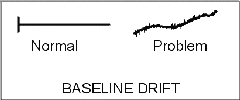| 1. Column temperature fluctuation |
1. a. Control column and mobile phase |
 (even small changes cause cyclic (even small changes cause cyclic |
 temperature temperature |
 baseline rise and fall; most baseline rise and fall; most |
 b. Use heat exchanger before detector b. Use heat exchanger before detector |
 often affects refractive index often affects refractive index |
|
 and conductivity detectors, or and conductivity detectors, or |
|
 UV detectors at high sensitivity UV detectors at high sensitivity |
|
 or in direct photometric mode) or in direct photometric mode) |
|
| 2. Nonhomogeneous mobile phase |
2. a. Use HPLC-grade solvents, high-purity |
 (drift usually to higher (drift usually to higher |
 salts, and additives salts, and additives |
 absorbance, rather than cyclic absorbance, rather than cyclic |
 b. Degas mobile phase before use b. Degas mobile phase before use |
 pattern from temperature pattern from temperature |
 c. Sparge with helium during use c. Sparge with helium during use |
 fluctuation) fluctuation) |
|
| 3. Contaminant or air buildup in |
3. a. Flush cell with methanol or other |
 detector cell detector cell |
 strong solvent strong solvent |
| |
 b. If necessary, clean cell with 1 n b. If necessary, clean cell with 1 n |
| |
 HNO3 (never with HCl) HNO3 (never with HCl) |
| 4. Plugged outlet line after detector |
4. a. Unplug or replace line |
 (high-pressure cracks cell (high-pressure cracks cell |
 b. Refer to detector manual to replace b. Refer to detector manual to replace |
 window, producing noisy baseline) window, producing noisy baseline) |
 window window |
| 5. Mobile-phase mixing problem or |
5. a. Correct composition/flow rate |
 change in flow rate change in flow rate |
 b. To avoid, routinely monitor b. To avoid, routinely monitor |
| |
 composition and flow rate composition and flow rate |
| 6. Slow column equilibration, |
6. a. Flush with intermediate strength |
 especially when changing especially when changing |
 solvent solvent |
 mobile phase mobile phase |
 b. Run 10–20 column volumes of new b. Run 10–20 column volumes of new |
| |
 mobile phase before analysis mobile phase before analysis |
| 7. Mobile phase contaminated, |
7. a. Check make-up of mobile phase |
 deteriorated, or prepared from deteriorated, or prepared from |
 b. Use highest grade chemicals and HPLC b. Use highest grade chemicals and HPLC |
 low-quality materials low-quality materials |
 solvents solvents |
| 8. Strongly retained materials in |
8. a. Use guard column |
 sample (high k) can elute as very sample (high k) can elute as very |
 b. If necessary, flush column with strong b. If necessary, flush column with strong |
 broad peaks and appear to be broad peaks and appear to be |
 solvent between injections or periodi- solvent between injections or periodi- |
 a problem a problem |
 ically during analysis ically during analysis |
| 9. Mobile phase recycled but |
9. a. Reset baseline |
 detector not adjusted detector not adjusted |
 b. Use new mobile phase when dynamic b. Use new mobile phase when dynamic |
| |
 range of detector is exceeded range of detector is exceeded |
| 10. Detector (UV) not set at |
10. Change wavelength to UV absorbance |
 absorbance maximum but at slope absorbance maximum but at slope |
 maximum maximum |
 of curve of curve |
|

|

